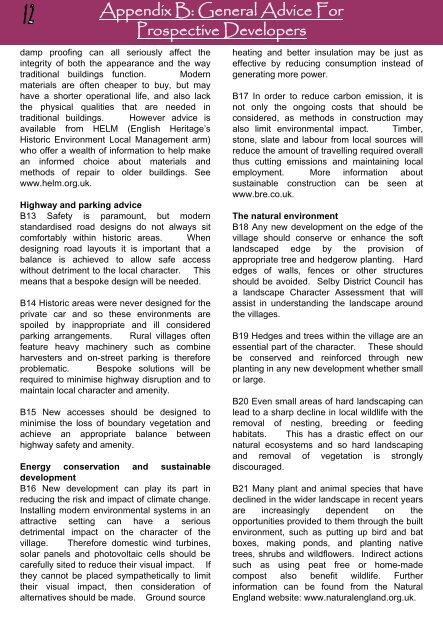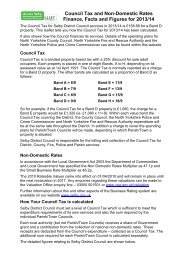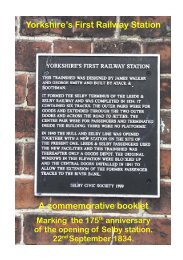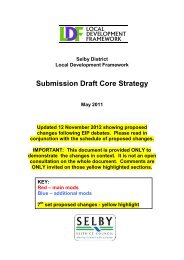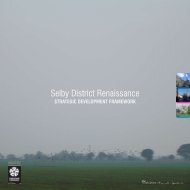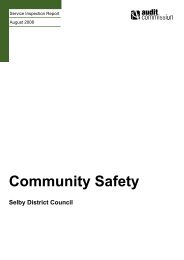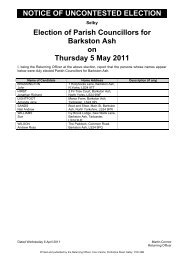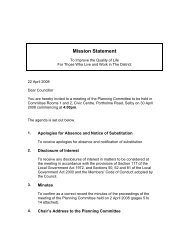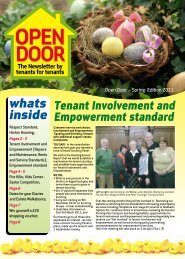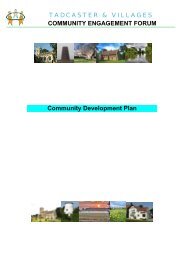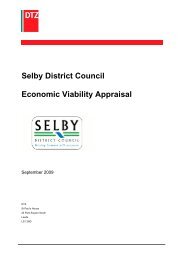Brayton - pdf - Selby District Council
Brayton - pdf - Selby District Council
Brayton - pdf - Selby District Council
You also want an ePaper? Increase the reach of your titles
YUMPU automatically turns print PDFs into web optimized ePapers that Google loves.
Appendix B: General Advice For<br />
Prospective Developers<br />
damp proofing can all seriously affect the<br />
integrity of both the appearance and the way<br />
traditional buildings function. Modern<br />
materials are often cheaper to buy, but may<br />
have a shorter operational life, and also lack<br />
the physical qualities that are needed in<br />
traditional buildings. However advice is<br />
available from HELM (English Heritage’s<br />
Historic Environment Local Management arm)<br />
who offer a wealth of information to help make<br />
an informed choice about materials and<br />
methods of repair to older buildings. See<br />
www.helm.org.uk.<br />
Highway and parking advice<br />
B13 Safety is paramount, but modern<br />
standardised road designs do not always sit<br />
comfortably within historic areas. When<br />
designing road layouts it is important that a<br />
balance is achieved to allow safe access<br />
without detriment to the local character. This<br />
means that a bespoke design will be needed.<br />
B14 Historic areas were never designed for the<br />
private car and so these environments are<br />
spoiled by inappropriate and ill considered<br />
parking arrangements. Rural villages often<br />
feature heavy machinery such as combine<br />
harvesters and on-street parking is therefore<br />
problematic. Bespoke solutions will be<br />
required to minimise highway disruption and to<br />
maintain local character and amenity.<br />
B15 New accesses should be designed to<br />
minimise the loss of boundary vegetation and<br />
achieve an appropriate balance between<br />
highway safety and amenity.<br />
Energy conservation and sustainable<br />
development<br />
B16 New development can play its part in<br />
reducing the risk and impact of climate change.<br />
Installing modern environmental systems in an<br />
attractive setting can have a serious<br />
detrimental impact on the character of the<br />
village. Therefore domestic wind turbines,<br />
solar panels and photovoltaic cells should be<br />
carefully sited to reduce their visual impact. If<br />
they cannot be placed sympathetically to limit<br />
their visual impact, then consideration of<br />
alternatives should be made. Ground source<br />
heating and better insulation may be just as<br />
effective by reducing consumption instead of<br />
generating more power.<br />
B17 In order to reduce carbon emission, it is<br />
not only the ongoing costs that should be<br />
considered, as methods in construction may<br />
also limit environmental impact. Timber,<br />
stone, slate and labour from local sources will<br />
reduce the amount of travelling required overall<br />
thus cutting emissions and maintaining local<br />
employment. More information about<br />
sustainable construction can be seen at<br />
www.bre.co.uk.<br />
The natural environment<br />
B18 Any new development on the edge of the<br />
village should conserve or enhance the soft<br />
landscaped edge by the provision of<br />
appropriate tree and hedgerow planting. Hard<br />
edges of walls, fences or other structures<br />
should be avoided. <strong>Selby</strong> <strong>District</strong> <strong>Council</strong> has<br />
a landscape Character Assessment that will<br />
assist in understanding the landscape around<br />
the villages.<br />
B19 Hedges and trees within the village are an<br />
essential part of the character. These should<br />
be conserved and reinforced through new<br />
planting in any new development whether small<br />
or large.<br />
B20 Even small areas of hard landscaping can<br />
lead to a sharp decline in local wildlife with the<br />
removal of nesting, breeding or feeding<br />
habitats. This has a drastic effect on our<br />
natural ecosystems and so hard landscaping<br />
and removal of vegetation is strongly<br />
discouraged.<br />
B21 Many plant and animal species that have<br />
declined in the wider landscape in recent years<br />
are increasingly dependent on the<br />
opportunities provided to them through the built<br />
environment, such as putting up bird and bat<br />
boxes, making ponds, and planting native<br />
trees, shrubs and wildflowers. Indirect actions<br />
such as using peat free or home-made<br />
compost also benefit wildlife. Further<br />
information can be found from the Natural<br />
England website: www.naturalengland.org.uk.


